Date Published February 25, 2020 - Last Updated September 2, 2020
Let’s face it, organizations often struggle with knowledge management. They often hold on to debunked knowledge management myths. Although I found many of these myths online, I didn’t find any definitive list; however, here are my favorites:
- If I share what I know, you’ll be able to get rid of me (my all-time #1)
- I don’t have time
- It’s a fad
- It’s an IT problem
- Knowledge management is about technology
- Knowledge management isn’t my problem
- You cannot capture “knowledge;” it’s too intangible
- If you build it, they will come
The intent of this article isn’t to discuss the pros and cons of knowledge management or to define knowledge management. There are far too many great scholarly articles, sites, and books on this topic. This article is about how the knowledge management practice interacts with the other ITSM practices based on ITIL* 4.
Practice vs. Process
First, practices and processes are not the same. A process defines the way tasks are organized while a practice defines the way the tasks are done. Here is a way to differentiate between the two. It is best illustrated using an example.
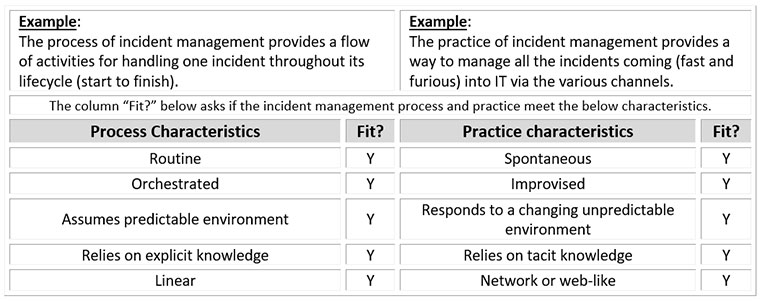
Please note the practice also provides a list of management activities to educate people, transfer and escalate incidents, report on incidents at various intervals, what information needs to be tracked, etc. The practice is also providing guidance on how to interact with the other practices such as service level management for target resolution times, problem management for workarounds, or change control for the change schedule. Of course, all 34 ITIL practices interact with each of the other 33 ITIL practices.
Knowledge Management Integration with Other Processes
As you design each practice you must identify the integrations points with the others practices. Regardless of your process maturity level, there is always some integration (inputs become outputs) that naturally takes place. In addition to gathering, processing, analyzing, utilizing, reviewing, and managing knowledge, the knowledge management practice also provides education, training, and coaching on how to use the document templates, as well as effectively and efficiently execute all the activities of the knowledge management practice.
As part of your role you may be executing the activities of many transactional processes such as developing applications, participating in projects, setting up hardware, producing reports, etc. It is important to recognize which process and possibly which procedure to use to execute the assigned task. Although possible, it is quite unlikely that someone would only execute the activities on one process each and every day. We execute the activities of many processes while being members of many practices as well.
In the examples below, the people’s jobs include performing the tasks on the left which are part of the practices on the right. This is only a small sample.
Example 1: Service Desk Analyst
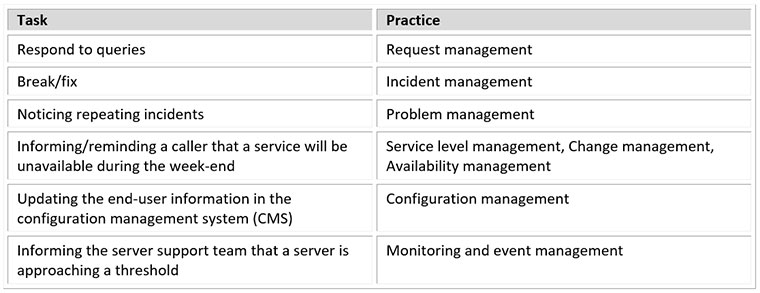
Example 2: Level 2 Application Analyst
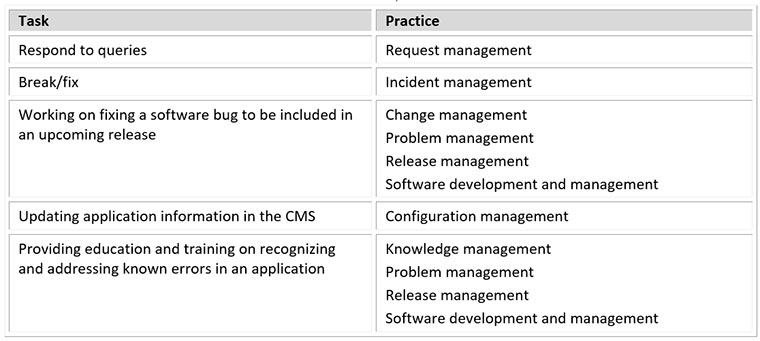
Example 3: IT Support Manager
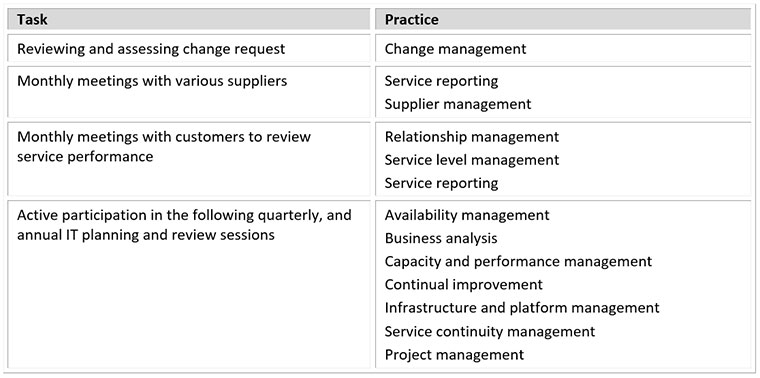
From Knowledge Management to All Other Practices
The knowledge management practice provides IT personnel—and others—with information sessions, education, and training about the knowledge management process. This occurs when the process is launched, at least annually, and when new personnel join as part of their onboarding. The knowledge management education and training covers how to use the knowledge management tool. The knowledge management practice provides access to the relevant knowledge management process-specific documents such as:
- Process policies, flows, procedures for all knowledge management activities
- Established and agreed upon process standards and templates for various documents in various media (Media could be document, spreadsheet, presentation, video, etc.)
- Process success factors, performance indicators, and metrics
- Process reports such as knowledge article usage report, knowledge article feedback and comments, Compliance non-compliance to the process, Scheduled training sessions completed with attendance, Ad-hoc coaching and training sessions
High Level Contents of Some Document Templates
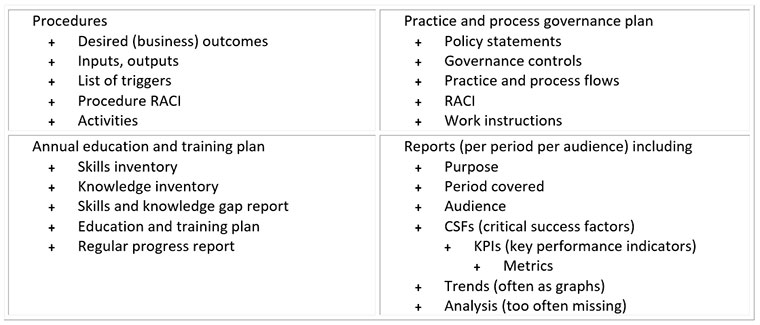
Knowledge Management Practice Activities
The knowledge management practice provides assistance on the following knowledge management practice activities:
- Identifying of knowledge articles required to support existing services and future services
- Conducting knowledge and skills inventory annually for existing staff and as part of onboarding for new staff
- Creating annual education and training plan for staff
- Knowledge management reporting
Knowledge Management Process Activities
The knowledge management practice provides assistance on the knowledge management process activities around the lifecycle of a knowledge article. You see, the knowledge management practice is performed by everyone. Yes, there may be a central group that owns the process and/or manage the knowledge management tool. However, the subject matter experts (SMEs) across IT are the ones that create the content. We have to acknowledge that not all SMEs are good at document creation; many have a hard time at moving thoughts to paper. This is where hiring technical writers can be very useful. They can interview the SMEs, create the contents, and review with the SMEs until the SMEs are satisfied with the contents before moving on to the next activity, the review. I strongly recommend that you create a request ticket to track the creation or the updating of knowledge articles. This will save you a lot of headaches.
The following lists the major activities to create knowledge articles and remove obsolete knowledge articles at regular intervals:
- Identify that a knowledge article is missing or a knowledge article needs to be updated
- Author (create/update) the knowledge article
- Review for content: standards (format), spelling, grammar
- Publish the knowledge article, add the knowledge article to the tool
- Inform the target audience the new/updated knowledge article is now available
- Use the knowledge article and provide feedback
- At regularly scheduled interval, conduct a review of various sets of knowledge articles to identify knowledge articles for removal
- Remove knowledge article from “production” and move to “archive” (just in case)
- Delete from archive after a pre-determined period
What’s Next?
The next step is for you to identify and describe “all” of the documents that each practice requires in order to be effective and efficient. Of course, once a process is completed, similar processes are easier to complete since the documents are fairly similar. Easier said than done.
* ITIL® is a (registered) Trademark of AXELOS Limited. All rights reserved.
Pierre Bernard is currently the Global ITSM Process Manager for IKO Industries. He has 34 years of experience in IT, 7 of those as a service desk manager. Pierre has helped numerous organizations and people learn about and understand the world of IT best practices. He has extensive experience, knowledge, and expertise in service management, organizational change, business management, and continual service improvement. Pierre also holds numerous certifications, including ITIL Expert, AGILE Foundation, PRINCE2 Practitioner, Master Trainer/Facilitator, COBIT5, ISO/IEC 20000, and ISO/IEC 27000. For those people who took an ITIL V2 Foundation (English or French) or Service Manager or an ITIL V3 Continual Service Improvement exam, you’ll be happy to know that Pierre is partly to blame. He was an examiner for those certifications. Connect with him on LinkedIn.